Do you have Wi-Fi here?
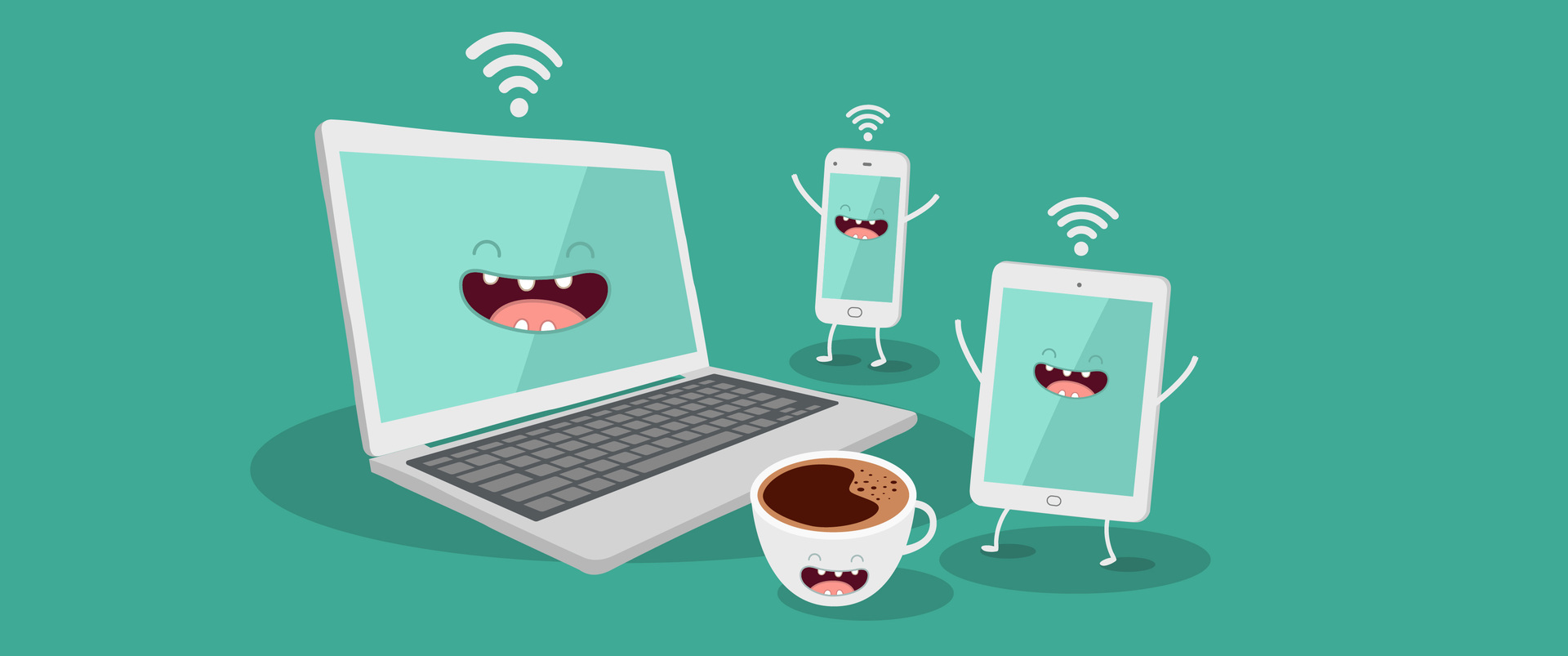
“Can’t you tell me the Wi-Fi password?” Is perhaps the most popular question in modern entertainment venues: restaurants, bars, cafes, etc.
Why are there restaurants and bars - the Internet has enveloped almost everything with its wireless networks: metro, theaters, offices, apartments, airports and train stations, industrial enterprises, beauty salons, libraries, gyms, shops ... This list goes on and on.
The main "culprit" of what is happening is all the painfully well-known data transfer protocol, popularly referred to as Wi-Fi.
And everything would be great - science serves the benefit of mankind, but here (however, as always happens) there are some nuances: progress dictates its own rules of the game, and this is reflected in all areas of our activity and especially on the work process.
Issue
According to analysts, already in 2019, the volume of user traffic transmitted via Wi-Fi networks will exceed the volume attributable to wired connections. “Extinction of wires” also affects user habits, which is natural: for example, stationary workplaces give way to mobility of employees, and a traditional work terminal (for example, a computer) is almost painlessly replaced by multiple smart devices.
The ongoing deformation of our user experience was expressed in the concept of All-wireless-office. The appearance of this term suggests that Wi-Fi technologies have reached a level of development that allows you to seamlessly solve existing problems and support new types of applications and services, for example, BYOD, high-definition video, virtual desktops, voice over Wi-Fi Fi
Obviously, if Wi-Fi access to the corporate infrastructure becomes a priority connection method, then more stringent requirements will be imposed on it in terms of security, quality of work, flexibility and scaling. Now the treasured piece of paper with a password, various autonomous access points and excuses of a system administrator like: “Well, what did you want from Wi-Fi ?! Connect by cable. ”
All this entails the need to modernize the WLAN infrastructure and implement modern Enterprise-level solutions. Here the first surprise arises: for the leadership of almost any enterprise or company, Wi-Fi simply works miraculously with the help of a “magic box”, which costs 3 thousand rubles. And "this is incomprehensible to the mind," as an access point can cost 30 or more thousand rubles! And "to you, IT specialists" give some kind of wireless controller!
There is a solution!
The search for the very “golden mean” is the determining factor in the development of our Huawei Enterprise solutions: maximum technological capabilities at a low cost. And without false modesty, we can say that we are succeeding in this matter . However, sometimes this is not enough: the cost of corporate-level solutions is orders of magnitude higher than the cost of consumer sales. At the same time, there are a number of manufacturers on the market that offer low-cost solution kits for SMB enterprises that are difficult to compete with.
A solution to this problem was found and embodied in the concept of Huawei Agile Distributed Wi-Fi: in addition to significantly optimizing the cost of equipment, this solution has unique technological features. Let's start with them.
A bit of technique
The architecture of the solution is slightly different from the traditional controller-based implementation. The solution still contains 2 types of devices: WLAN controllers (AC) and directly access points (AP). The main difference is that access points are now divided into two types: central access points (Central AP) and remote radio modules (RRU - Remote Radio Unit):
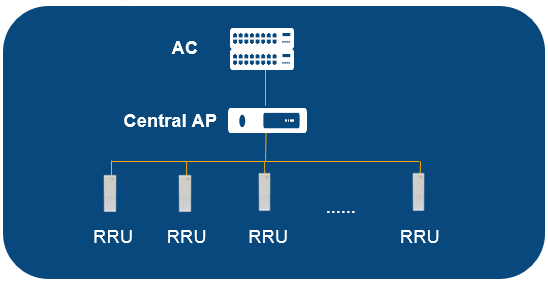
RRU - simplified access points (if you want, light-lightweight APs or remote radio modules) that are not involved in traffic processing. Their main task: processing 802.11 frames, converting to 802.3 (and vice versa from wired Ethernet to wireless 802.11) and transferring this traffic through a CAPWAP tunnel to Central AP (optionally with DTLS encryption). In addition, each RRU module is independent.
Central AP is the root access point that does not have built-in radio modules. She is responsible for managing RRUs, processing and forwarding RRU traffic, processing and providing QoS profiles, filtering and enforcing security rules, ACLs, IPSs, and application identification. In addition, Central AP is responsible for the association of user devices and their roaming between RRUs. Interaction with RRU modules and a wireless controller is provided through a CAPWAP tunnel. It is also important that the root access points take over part of the functions of the wireless controller and thereby significantly relieve it.
The solution can be three-level (controller + Central AP + RRU) or two-level (Central AP + RRU):

In a two-tier architecture (Central AP + RRU), the central access point will act as a standalone (Fat AP), i.e. Wireless and radio frequency parameters, authorization rules and policies, DHCP and other network services will be configured directly on Central AP, there is no WLAN controller. In stand-alone operation, we also get the possibility of centralized management, since the RRU modules do not require an individual configuration. Obviously, such an architecture is mainly applicable for small deployment scenarios (SOHO and SMB level, but even here there is an alternative that does not require the purchase of additional equipment, in the form of a Huawei cloud controller).
At the physical level, remote RRU radio modules can be connected directly to Central AP directly over a twisted pair cable (distance is up to 100 meters, PoE is powered by Central AP), or through one or more switches. A prerequisite for interaction: Central AP and RRU must be in a single broadcast domain, i.e. there should be a Layer-2 connectivity between them.
Zero touch roaming
Another interesting technical feature is the implementation of roaming within Central AP between RRUs. This functionality is called Zero-touch roaming (ZTR).
Zero-touch roaming does not mean that there is no roaming at all, but that user terminals do not determine the roaming process, they do not need to perform any actions.
As you know, with the traditional ESS architecture and the transition of the user from the coverage area of one access point to another, the roaming process occurs. The logic and switching algorithms depend on the manufacturer and the specific implementation, but, one way or another, the user terminal must take a series of actions for roaming to take place. In an Agile Distributed Wi-Fi solution, each terminal that successfully passes the authentication and association process is assigned and assigned an individual virtual AP BSSID (access point identifier, MAC address equivalent): the user can move from the coverage area of one RRU to the zone of another, but BSSID will be unchanged. From the point of view of the user terminal, it will always be connected to one access point.
How, then, is switching from one point of the RRU to another? Traditionally, the user device itself controlled the RSSI levels of each reachable access point. In the Agile Distributed Wi-Fi solution, everything happens exactly the opposite: the central AP Central AP collects information about how each RRU module “hears” the user terminal (= RSSI), and then makes the decision to switch.
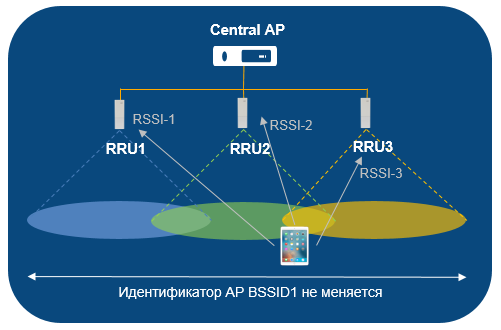
The process is as follows:
- The terminal successfully connected to the network, and a unique identifier for the access point BSSID1 was allocated and assigned to it (while still at the connection stage, the central access point determined which RRU module would provide the best quality for the user - for example, RRU1).
- At some point in time, the user changes the dislocation and finds himself in the zone of better coverage by the RRU2 module. The central access point, listening to RRU1 and RRU2, decides to switch the user to RRU2. In order to prevent any traffic intended for the user from being lost during the roaming process, the central access point starts saving it to the buffer.
- The next step, RRU1 stops broadcasting BSSID1, and this identifier goes to RRU2. The user is transferred to RRU2, but for himself, BSSID1 has remained unchanged.
- As a last step, the central access point sends information to the user from the buffer. The total switching time is not more than 50 ms.
Part of the equipment
Wireless Controller (AC):
| Model | AC6605 | AC6005 | AC6003 | ACU2 |
|---|---|---|---|---|
| Supported Qty RRU | 1024 | 256 | 48 | 2048 |
| Supported Number of Central AP | 128 | 32 | 6 | 256 |
Central AP:
 |  | |
|---|---|---|
| Model | AD9430DN-24 | AD9430DN-12 |
| Supported Qty RRU | 24 (48 when connected via a PoE switch) | 12 (24 when connected via a PoE switch) |
| Maximum number of users | 4096 | 2048 |
| Interfaces | 4 x Gigabit Combo Interfaces 24 x Downlink Interfaces | 2 x gigabit combo interfaces 12 x downlink interfaces |
| PoE power output support | 24 x R230D / R240D | 12 x R230D | 6 x R240D |
| Place of installation | Server or cross room, cabinet | Any place indoors |
RRU Modules:
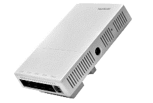 |  | |
|---|---|---|
| Model | R230D / R240D | R250D |
| Supported Wi-Fi Standards | 802.11b / g / n 802.11a / n / ac | 802.11b / g / n 802.11a / n / ac Wave2 |
| Mimo | 2x2 | 2x2 MU-MIMO |
| Bandwidth (2.4 + 5 GHz) | 300 Mbps + 867 Mbps | 400 Mbps + 867 Mbps |
| Antenna Type | Integrated | Integrated |
| Wired interfaces | 1 x FE (R230D) 1 x GE, 4 x FE, 2 x RJ11 (R240D) | 2 x GE |
| Nutrition | PoE (R230D) DC / PoE (R240D) | PoE |
| Mounting options | Wall ceiling | Wall ceiling |
A comparison of the latest RRU R250D and lightweight access points of the latest generation AP4050DN looks curious: they provide the same bandwidth - 1.267 Gbit / s in the 2.4 and 5 GHz bands, have similar radio frequency parameters, a single type of integrated antenna, support up to 256 users. They are identical in terms of functionality: RRU modules in conjunction with Central AP and the controller will also dynamically select channels and power, detect interference sources, monitor the real-time radio environment, and balance between frequency bands and neighboring access points.
Issue price
The cost of Agile Distributed Wi-Fi is one of the key advantages of the solution: remote RRU modules are deprived of expensive chipsets, all processing is centralized and transferred to root access points. Due to this, the cost of RRU modules is almost 3 times less than similar traditional lightweight access points. Of course, a necessary element of the solution is the Central AP module, which also costs some money. But the root access point supports up to 24 or 48 RRU modules - in this case, the cost of Central AP will be distributed between them, which will increase the cost of RRU by only 7-10%.
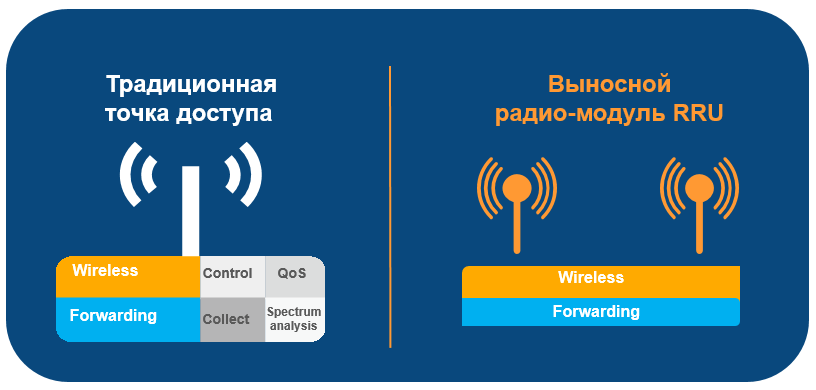
The second thing you can save on is access point licenses for the wireless controller: traditionally, AC licenses must be licensed in an amount equal to the total number of access points. In the solution to this article described in this article, licenses need to be laid down only on central access points, but not RRU modules.
A simple example: there is an office, which requires about 90 access points to cover. With the standard approach, we will buy 90 lightweight access points + controller + 90 licenses. A similar solution built using Agile Distributed Wi-Fi will require the same 90 RRU modules + controller + total of 2 licenses (for Central AP). As a rule, at least 8 licenses already come with the controller for free, i.e. nothing to buy and do not have to.
For the centralized management and monitoring system NMS eSight, the number of Central AP elements will also matter, and here we will significantly save on the cost of licenses.
Application area
The Agile Distributed Wi-Fi solution has many advantages, but, of course, this is not a panacea for everything and everything: Wi-Fi scenarios with a high user density, outdoor deployment and mesh connectivity, narrowly targeted sector coverage - these tasks should be implemented using specialized products and solutions.
But for the lion's share of campus scenarios, especially for hospitals and hotels with many separate rooms, offices and enterprises with complex internal layouts, this solution is perfect. Again, we can significantly improve the quality of coverage by simply increasing the number of RRU modules (due to their low cost and the absence of the need for additional licenses, we can afford it).
The Agile Distributed Wi-Fi solution makes Enterprise-level wireless data infrastructure much more affordable and can increase the number of potential customers.
Instead of conclusions
Since our main goal is to find solutions for specific problems of users, your experience in using Huawei Enterprise products is very valuable to us. Do not be too lazy to share this experience with us (both positive and negative) in the comments, if any :)
